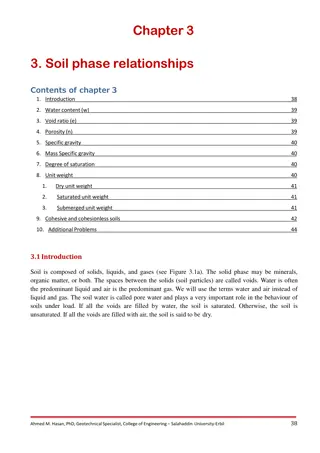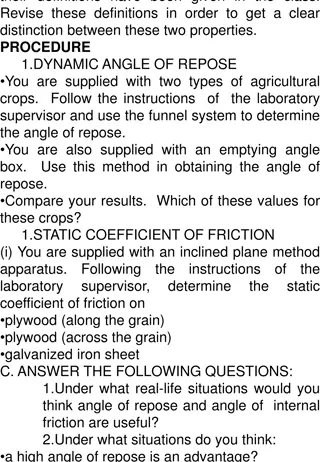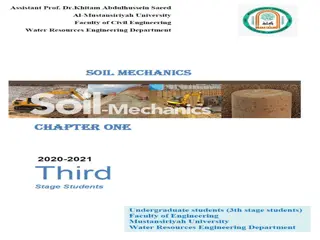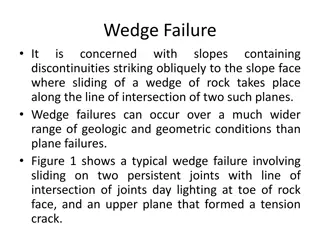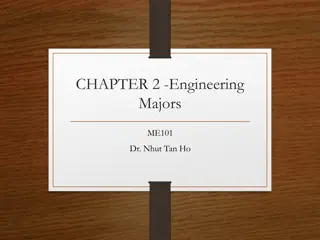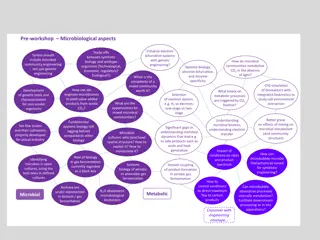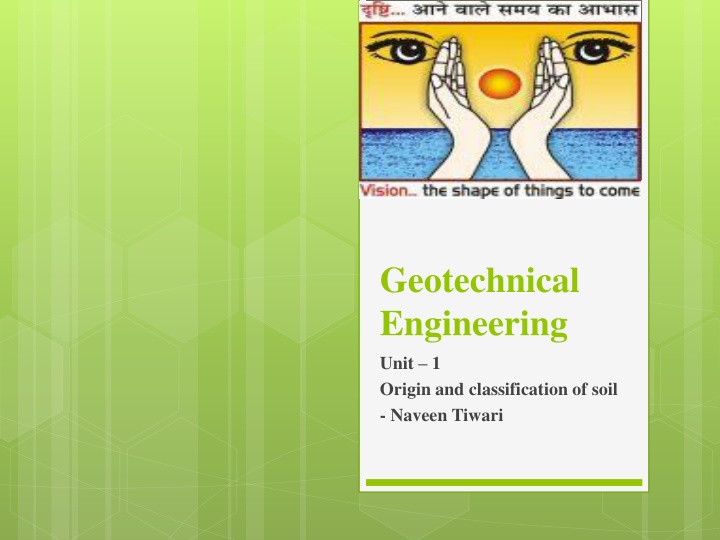
Soil Properties and Water Content Determination Methods
Explore the origin and classification of soil, phase relationships, index properties, and methods for determining water content in soil samples. Learn about geotechnical engineering and the importance of analyzing soil properties for various engineering purposes.
Download Presentation

Please find below an Image/Link to download the presentation.
The content on the website is provided AS IS for your information and personal use only. It may not be sold, licensed, or shared on other websites without obtaining consent from the author. If you encounter any issues during the download, it is possible that the publisher has removed the file from their server.
You are allowed to download the files provided on this website for personal or commercial use, subject to the condition that they are used lawfully. All files are the property of their respective owners.
The content on the website is provided AS IS for your information and personal use only. It may not be sold, licensed, or shared on other websites without obtaining consent from the author.
E N D
Presentation Transcript
Geotechnical Engineering Unit 1 Origin and classification of soil - Naveen Tiwari
Geotechnical Engineering Geotechnical engineering is an area of civil engineering that focuses on the engineering behaviour of earth materials.
Origin of soil Soil forms continuously, but slowly, from the gradual breakdown of rocks through weathering. Weathering can be a physical, chemical or biological process: physical weathering breakdown of rocks from the result of a mechanical action.
Phase Relationship of Soil For the purpose of engineering analysis and design, it is necessary to express relations between the weights and the volumes of the three phases.
Index Properties of Soil Soil index properties refer to the properties of the soil that help to classify and identify the properties of soil for purposes of engineering. For example, clay is generally cohesive in nature and sand and gravel are described as granular and non-cohesive.
Determination Of Water Content Oven Dry Method - Oven dry method is the most accurate and simplest method for water content determination. In this method complete drying of soil sample occur and water content in sample is calculated accurately by a maintained temperature in the oven ( 105 C to 110 C) for 24 hours.
Determination Of Water Content Sand Bath Method - Sand bath method is a field method conducted to determine the water content of the soil. This method is fast but the result is not as accurate as the oven-dry method.
Determination Of Water Content Pycnometer Method - Pycnometer method is used to determine specific gravity and water content both. This method is suitable for cohesionless soils. Pycnometer is a glass jar of 1-liter capacity that is fitted at its top by a conical cap made of brass. It has a screw type cover and there is a small hole at its apex of 6 mm diameter.
Determination Of Water Content Rapid Moisture Meter - To quickly determine the water content at site, use of Rapid Moisture Meter is very advantageous. In this method, water content is determined from the gas pressure developed by the reaction of calcium carbide (Absorbent) with free water of the soil sample.
Particle size distribution curve The particle size distribution curve is a graph that is generated to illustrate the average particle size, the smallest particle size, and the largest particle size. The curve illustrates either the amount of material that passes through or is retained on each sieve.
Atterberg Limits The Atterberg limits are a basic measure of the critical water contents of a fine-grained soil: its shrinkage limit, plastic limit, and liquid limit. Depending on its water content, soil may appear in one of four states: solid, semi-solid, plastic and liquid.
Soil classification system Unified Soil Classification System- According to USCS, the coarse-grained soils are classified on the basis of their grain-size distribution and the fine-grained soils on the basis of their plasticity characteristics.
Soil classification system AASHTO classification system- The AASHTO Soil Classification System classifies soils into seven major groups A-1 to A-7. Most of the major groups have subgroups based on the gradation, plasticity index, and group index
Soil classification system Indian Standard Soil Classification System (ISSCS) - In the Indian Standard Soil Classification System (ISSCS), soils are classified into groups according to size, and the groups are further divided into coarse, medium and fine sub- groups. The grain-size range is used as the basis for grouping soil particles into boulder, cobble, gravel, sand, silt or clay.
Indian Standard Soil Classification System (ISSCS) Plasticity Chart


